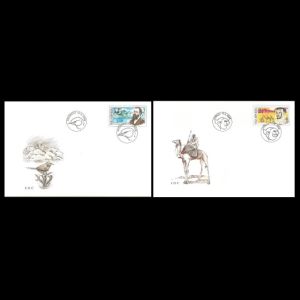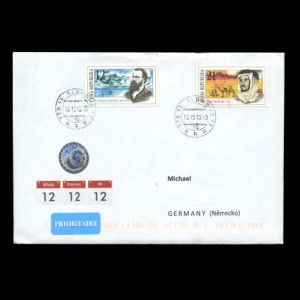Czech Republic (Czechia) 2008 "Explorers"
| <prev | back to index | next> |
| Issue Date | 18.06.2008 |
| ID | Michel: 566-567; Scott: 3392-3393; Stanley Gibbons: 552-553; Yvert et Tellier: 510-511; Category: pP |
| Design | Graphic designer: Vladimr Novak Engraver: Milos Ondracek |
| Stamps in set | 2 |
| Values |
12 CZK - Explorers: Ferdinand Stolicka 21 CZK - Explorers: Alois Musil |
| Emission/Type | commemorative |
| Places of issue | Kromeriz and Viskov |
| Size (width x height) | 40mm x 23mm |
| Layout | 50 stamps in Sheet: 5x10 |
| Products | FDC x2 |
| Paper | fluorescent |
| Perforation | 12 x 11.25 |
| Print Technique | rotary recess print in black combined with photogravure in dark red, yellow, black and ochre |
| Printed by | Post Printing House |
| Quantity | 2,000,000; 1,000,000 |
| Issuing Authority | Czech Post |

On June 18th, 2008, Post Authority of Czech Republic issued a set of two stamp: "Explorers". One of the stamps shows Czech paleontologist - Ferdinand Stolichka.
Ferdinand Stolicka (1838-1874)
 |
| Ferdinand Stolichka on explorer stamps of Czech Republic 2008 MiNr.: 566, Scott: 3392. |
Ferdinand Stolicka graduated in geology from the Faculty of Arts in Vienna. He did mapping in the Eastern Alps, in Hungary and Dalmatia. As a paleontologist of the Indian Geological Institute, he researched mainly the Himalaya and the Karakoram. He went on his first journey to the Himalayas in 1864.
During the four-month expedition he created geological maps of extensive areas of the mountains; in particular, he defined the core of the Himalayas as consisting of gneiss layers covered with by primary and secondary sediments. He contributed also to other disciplines, mainly to ornithology. On his return from the third expedition to the Himalaya he died, probably of high mountain disease. The extent of Stolicka's scientific work is admirable.
 |
| Alois Musil on explorer stamps of Czech Republic 2008 MiNr.: 567, Scott: 3393. |
After graduation from the Faculty of Theology in Olomouc, the world-famous Czech geographer, orientalist and traveler Alois Musil continued his studies in Jerusalem and Beirut. He travelled through Arabia and made detailed maps there.
He was engaged in ethnography and botany. In addition to world languages, he had a command of 35 Arabian dialects. He became the sheikh of two tribes.
Bedouins brought Musil to his greatest discovery - they showed him the mysterious 8th century building in the desert Kuseir Amra in the territory of today's Jordan.
After World War I he was appointed professor at Charles University for oriental sciences and the Arabian language. With President Masaryk's support, Musil initiated the foundation of the Oriental Institute.
He contributed to the popularity of the Near East and published dozens of traveler's books for the youth and adults.
Products and associated philatelic items
| FDC | Example of circulated covers | |
 |
 |
|

|
- Technical details: Colnect Czech Post
Acknowledgement:
Many thanks to Dr. Peter Voice, PhD Department of Geological and Environmental Sciences, Western Michigan University, USA, for his help in finding information and for review of a draft of this article.
| <prev | back to index | next> |